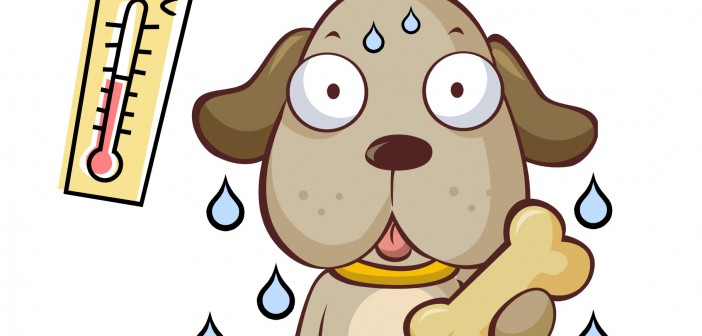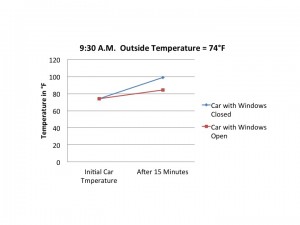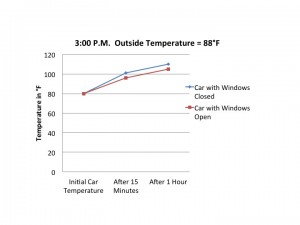My first experience in a sauna ended in a panic attack. What if I get heat stroke? What if I pass out and nobody comes to find me? Could I suffocate from the heat? And, from my teenage years of watching campy horror movies, what if someone traps me in here and turns up the heat more!? The endless questions kept me from enjoying the experience. I ran from that sauna leaving a trail of steam and a towel flapping in my wake. Little did I know, these questions that led to my panic attack in the sauna were and are the reality for many dogs that don’t have the opportunity to escape. The only difference is my experience was in a sauna and this happens to dogs in cars every day.
Hot Cars
Each year thousands of dogs across the US die from being left in hot cars. Unfortunately, a portion of those deaths take place in Utah. We may have bitter cold winters, but we have brutally hot summers. The average Salt Lake valley high summer temperatures are:
- June: 82.2°F
- July: 90.6°F
- August: 88.7°F
However, on an average of five days per year, the temperature will exceed 100 degrees Fahrenheit. This combined with the direct rays of the sun can create an extremely hot car. In order to find out what the blazing sun of Utah can truly do to the temperature of a car, Pets in the City conducted our own experiment. Here are the results:
The experiment was conducted on June 27, 2012 in Salt Lake City. The high temperature for that day was 88°F, which is in range of the average high summer temperatures in the Salt Lake valley. Where your car is parked and how the sun’s rays are hitting your car can affect the temperature, but you can expect similar results.
Having the windows open made little difference in the interior temperature of the car. It’s not enough to leave the windows open because the temperature will still rapidly rise even with a source of ventilation. Another point to consider is the temperature under which this experiment was conducted. The temperature was 88°F at the hottest part of the day. The Salt Lake valley can and does get much hotter, which can easily increase the temperature of the interior of a car in excess of 120°F.
The Law
When animals experience these types of temperatures in a car, they suffer. This is considered a form of animal abuse. In Utah, law makers have taken action against those who leave their dogs and companion animals in a car unattended. The Utah law states, “It is unlawful for any person to carry or confine any animal in or upon any vehicle in a cruel or inhumane manner, including but not limited to carrying or confining such animal without adequate ventilation or for an unusual length of time.” A person in violation of this law could be charged with a crime, face fines or prison time, and expect possible damage to their car in order to release the animal. If you see a dog or animal confined in a car, contact the local police or animal control.
How You Can Help
Because dogs are less adept at cooling off than their caretakers, they are prone to overheating. Heat exhaustion of a dog can lead to heart failure, brain and organ damage, and death. Watch for signs of overheating such as lethargy, restlessness, heavy panting, excessive thirst, lack of appetite, rapid shallow breathing, dark red or purple tongue, extremely high body temperature, lack of coordination, and vomiting. If you see any of these symptoms, immediately get the dog into a cooler area and gradually lower his body temperature by providing drinking water and applying cool compresses to the head, neck, and belly or soak him in cool, not cold, water. Due to the seriousness of heat exhaustion, immediately seek professional veterinarian care for the dog.
Here are some useful tips to help your dog beat the summer heat:
- When taking your dog out for a walk or hike go during the cooler hours of the day, like the early morning or late evening.
- Whether you’re being active or just lounging in the backyard with your dog, always have plenty of fresh cold water available.
- When outdoors make sure to have a shady spot for your dog to cool off. Adding a kiddie pool for your dog to play in or a cool damp towel for your dog to lay on while in the shade is a fun and effective way to keep your dog cool.
- Dogs can get sunburned, especially pale and shorthaired dogs. Keeping your dog appropriately groomed will help protect him from the sun and also help keep him cool. It can be beneficial to use a sunscreen specifically for animals on your dog’s nose and tips of his ears.
- A dog’s paws are easily burned on outside surfaces, like asphalt and cement. Test outside surfaces with your hand, if it’s too hot for you, it’s too hot for your dog.
- Never leave your dog unattended in a car or small enclosure that can lead to heat exhaustion and suffering.
Keeping your dog safe and cool in the summer heat will help both you and your companion fully enjoy the summer months. Just remember, if it’s too hot for you, it’s too hot for Spot.
By Elizabeth Cornwall and Megan Waller






